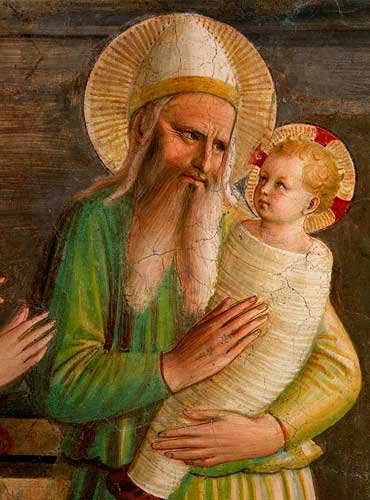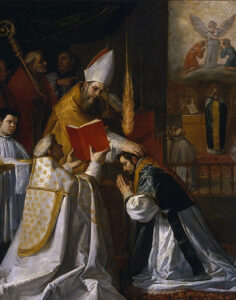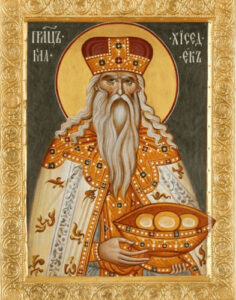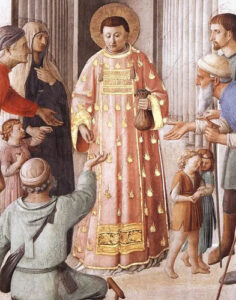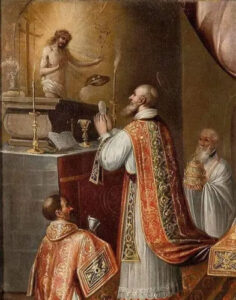Feast of the Presentation – February 2nd
Today we celebrate the Feast of the Presentation of the Child Jesus, and also the World Day for Consecrated Life, because, just as Jesus was offered in the Temple, so consecrated persons also offer themselves entirely to God. For today’s feast, let’s first consider what is being celebrated, and, second, what virtues we can take from it to apply to our own lives.
First, in the Presentation of the Child Jesus, what is also being recalled (and is the reason why the Holy Family is there in the first place) is the purification of Mary. It is based on a precept of the law: “When a woman had borne a child, if it was a boy, she was unclean for forty days, if it was a girl, for eighty days. She could go about her household and her daily business but she could not enter the Temple or share in any religious ceremony (Lv 12:1-8). At the end of that time she had to bring to the Temple a lamb for a burnt offering and a young pigeon for a sin offering. That was a somewhat expensive sacrifice, and so the law laid it down (Lv 12:8) that if she could not afford the lamb she might bring another pigeon. The offering of the two pigeons instead of the lamb and the pigeon was technically called The Offering of the Poor. It was the offering of the poor which Mary brought. Again we see that it was into an ordinary home that Jesus was born, a home where there were no luxuries, a home where every penny had to be looked at twice, a home where the members of the family knew all about the difficulties of making a living.”
Nonetheless, there is also another, more profoundly theological reason why Mary didn’t bring a lamb to sacrifice, and that is, because in bringing her Son, Jesus Christ, she has brought the true and definitive Lamb of God. Likewise, Mary was completely sinless, before and after Jesus’ birth; she had no need to be purified, as it were, but, in the Summa, Aquinas explains why it was appropriate for her to go, and, indeed, why Christ was circumcised, and fulfilled all the precepts of the law. The Angelic Doctor, asking if it was fitting for Mary to go to the Temple to be purified, writes: “As the fullness of grace flowed from Christ on to His Mother, so it was becoming that the mother should be like her Son in humility: for ‘God gives grace to the humble,’ as is written in James 4:6. And therefore, just as Christ, though not subject to the Law, wished, nevertheless, to submit to circumcision and the other burdens of the Law, in order to give an example of humility and obedience; and in order to show His approval of the Law; and, again, in order to take away from the Jews an excuse for calumniating Him: for the same reasons He wished His Mother also to fulfill the prescriptions of the Law, to which, nevertheless, she was not subject” (ST, III, q. 37, a. 4). Again, the same two virtues stand out: humility and obedience, both of Jesus and of Mary, the first and best disciple of Christ.
That should suffice for a little history; we can, for our general observations, consider some remarks given by Pope Emeritus Benedict XVI on the feast of the Presentation. “It is interesting to take a close look at this entrance of the Child Jesus into the solemnity of the temple, in the great comings and goings of many people, busy with their work: priests and Levites taking turns to be on duty, the numerous devout people and pilgrims anxious to encounter the Holy God of Israel. Yet none of them noticed anything. Jesus was a child like the others, a first-born son of very simple parents.
Even the priests proved incapable of recognizing the signs of the new and special presence of the Messiah and Savior. Alone two elderly people, Simeon and Anna, discover this great newness. Led by the Holy Spirit, in this Child they find the fulfillment of their long waiting and watchfulness. They both contemplate the light of God that comes to illuminate the world and their prophetic gaze is opened to the future in the proclamation of the Messiah: ‘Lumen ad revelationem gentium!’ (Lk 2:32). The prophetic attitude of the two elderly people contains the entire Old Covenant which expresses the joy of the encounter with the Redeemer. Upon seeing the Child, Simeon and Anna understood that he was the Awaited One.”
Here, we see the need for recollection; Jesus comes into the Temple, and no one notices. All the priests, all the people, are supposedly ‘busied with the things of God,’ but they miss God Himself. If you’ve read Five Loaves and Two Fishes, by Venerable Francis-Xavier Cardinal Van Thuan, you might recall the scene where he is imprisoned, lamenting the fact that he isn’t doing anything for God’s people. It’s at that point that he hears God tell him: “‘Why do you torment yourself so? You must distinguish between God and the work of God. You must choose God alone, and not his works.” The things, the works Van Thuan had done were good, but it was really God working through him. Now, if God called him to minister to “his cathedral,” meaning, the prison boat full of other suffering, dying, and in chains, he would do that, because that’s where God was, waiting to be found. In Jn 8:29, we hear that this is the way Jesus lived: He tells the crowds “The one who sent me is with me. He has not left me alone, because I always do what is pleasing to him.” At every moment, I am focused on Him and on His will in the moment. I see Him behind every tree, in every sinner, in every person who comes attacking Me and insulting Me, and I love them nonetheless.
In the Presentation, we see how Christ gives Himself up entirely for us. Benedict continues: “The Presentation of Jesus in the Temple is an eloquent image of the total gift of one’s life for all those, men and women, who are called to represent ‘the characteristic features of Jesus — the chaste, poor and obedient one’ in the Church and in the world, through the evangelical counsels.
The evangelical image of the Presentation of Jesus in the Temple contains the fundamental symbol of light; the light that comes from Christ and shines on Mary and Joseph, on Simeon and Anna, and through them, on everyone. The Fathers of the Church connected this radiance with the spiritual journey. The consecrated life expresses this journey, in a special way, as ‘philokalia,’ love of the divine beauty, a reflection of God’s divine goodness. On Christ’s Face the light of such beauty shines forth.”
There is much there to consider: Fulton Sheen, too, make mention of this light. “Simeon was like a sentinel whom God had sent to watch for the Light. When the Light finally appeared, he was ready to sing his Nunc Dimittis. In a poor child brought by poor people making a poor offering, Simeon discovered the riches of the world.” Saint John tells us in his prologue that What came to be through [the Word] was life, and this life was the light of the human race; the light shines in the darkness, and the darkness has not overcome it (1:4-5). The Light, Christ Himself, comes into the Temple, into the world, and shines on all men, to show them the way back to the Father. Poverty, chastity, obedience, trust in God, fidelity to His will, a love of the divine beauty, a desire to seek that beauty and service in everything . . . that is what we see here.
We can note, very briefly, two details contained in Simeon’s prophecy, as one commentator explains them. In Lk 2:34-35, Simeon tells Mary, Behold, this child is destined for the fall and rise of many in Israel, and to be a sign that will be contradicted (and you yourself a sword will pierce) so that the thoughts of many hearts may be revealed. There are two things to consider:
“[Christ] will be the cause whereby many will fall. This is a strange and a hard saying but it is true. It is not so much God who judges a man; a man judges himself; and his judgment is his reaction to Jesus Christ. If, when he is confronted with that goodness and that loveliness, his heart runs out in answering love, he is within the Kingdom. If, when so confronted, he remains coldly unmoved or actively hostile, he is condemned. There is a great refusal just as there is a great acceptance.
[Also], Christ will meet with much opposition. Towards Jesus Christ there can be no neutrality. We either surrender to him or are at war with him. And it is the tragedy of life that our pride often keeps us from making that surrender which leads to victory.”
Today, as we recall the Presentation of Christ in the Temple, let us ask, through the intercession of Mary, Mother of Light, for the graces of recollection and complete surrender of self to God and to His will.

